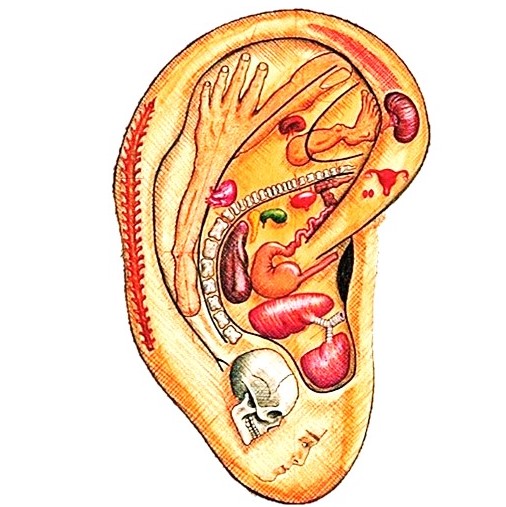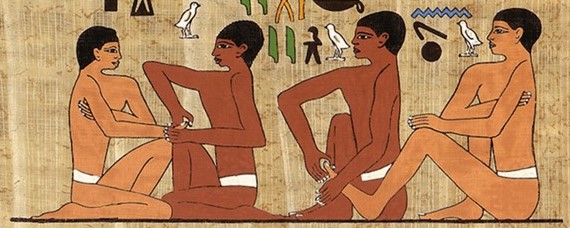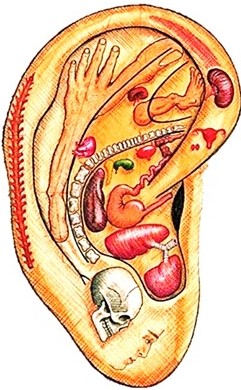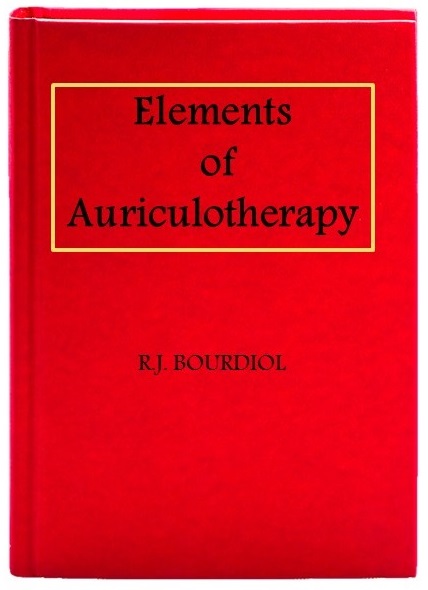The Daith piercing as a possible layman’s treatment option for those who suffer from headaches and migraine headaches
By John Howard, L.Ac., Dipl. Ac. And Eric Serejski, L.Ac., Dipl. Ac, Ch.
Statement of Intent
The purpose of this article is to help further the dialog, research and if possible, clinical trials on the daith piercing. Many in the healthcare field and piercing industry have put to rest that the daith piercing is not a viable treatment option for those who suffer from headaches and migraine headaches. What’s disconcerting to me, is how they arrived at this conclusion. The main argument put forth by the “experts” was based on the erroneous philosophy of auriculotherapy (ear acupuncture). This flawed argument put forward by the “experts” must be corrected. I will do this by delineating the factual principles of auriculotherapy and introduce the direct connection between the daith piercing and the Vagus Nerve via the multiphase system of auriculotherapy.
Introduction
The aim of this paper is to analyze the medical claims that have been reported by those in the piercing community and their clients regarding The Daith piercing’s (1) (TDP) ability to reduce or rid those in pain. More specifically headaches and migraine headaches of unknown etiology. I will try to put forward a working hypothesis that can verify and back up those claims. Reports began to surface shortly after TDP’s inception in the latter part of the 20th century.
Claims
TDP (ear piercing in the root of the helix) has been reported as a therapy by those who suffer from headaches and/or migraine headaches. Some individuals who have received TDP claimed treatment results they experience range from total elimination to reduction in intensity and frequency of headaches and/or migraine headaches.
Now, there is very little clinical evidence to back up the claims of TPD as a viable therapy to those who suffer from headaches or migraine headaches.
In late 2015, The Association of Professional Piercers released a statement to their members (2) about TDP. They respectfully asked for their members to refrain from making any claims to prospective clients regarding TDP as a medical treatment for headaches. The email went on to say that there are no scientific bases to back up or refute these claims now.
A comprehensive review was conducted of published literature about TDP. The parameters of our review included both scientific journals and articles written by medical professionals. We found no peer review studies in PubMed about TDP. Considering this information, we narrowed our focus to search for articles written by experts in this field. An analysis of this body of work revealed a fundamental misconception that acupuncture more precisely auriculotherapy (also known as ear acupuncture or auricular acupuncture) is most likely the modality behind these claims both for and against TDP as treatment for headaches or migraine headaches.
The term “ear acupuncture” is mostly misunderstood by those who use it as an argument to explain TDP outcome. Regardless of the articles’ final conclusions as being in favor of, or against TDP as a therapy, this misunderstanding seems to be a common mistake.
Understanding the Facts
If this therapy is not ear acupuncture (auricular acupuncture), an adjunct therapy to body acupuncture, then what is it? The correct term for this type of therapy is auriculotherapy (3) (also known as auricular therapy), where solely the ear is used to discuss and treat your patient’s pathology. There is a fundamental difference between these treatments, ear acupuncture and auriculotherapy, but the terms are erroneously used interchangeably by those in the medical community.
Definitions
Our hypothesis on TDP is based on scientific merit, to start its paramount we first have a clear definition of the facts upon which we base this claim. We shall define the following terms: piercings, auriculotherapy (auricular therapy), ear acupuncture (auricular acupuncture).
Piercings
Piercing (also known as body piercing a form of body modification) first needs a definition. Simply stated, it is a decorative practice of puncturing and or cutting into any part of the human body in which to insert jewelry.
Body piercing is not a new phenomenon, there is documented evidence dating this practice back to the Mesolithic period (8000 – 2700 BC). Piercings have also been observed in many cultures throughout the world. It is believed that the daith piercing (not called the daith piercing until the 1990s) has been around for 3,000 years (4).
TDP was co-invented in 1992 by Erik Dakota and one of his female clients. Dakota’s client who at the time was studying Hebrew in college, named the piercing da’at, meaning knowledge.
 Daith Piercing pictured above
Daith Piercing pictured above
TDP is in the part of the ear known as the root of the helix (the root of the helix divides the concha into the superior hemi concha commonly referred to as the cymba conchae and the inferior hemi concha referred to as the cavum conchae). TDP can be obtained at many tattoo and piercing shops found around the country. TDP procedure takes about 10 minutes and costs under $100. The popularity of TDP has grown in part to its inexpensive cost combined with its drug-free treatment approach.
Auriculotherapy
Simply said, it is a therapy using the stimulation of specific areas accessible on the surface of the ear. Those stimulations are effected by use of, for example, needles, pressure, electricity, laser and light.

Copyright 2017 by Nader Soliman, MD. Reprinted by permission
One of the earliest rudimentary forms of auriculotherapy (also known as auricular therapy) can be traced back to the tomb of Egyptian physician Ankmahor of Saqqara (5) (circa 2500-2330 BC). The tomb was first excavated by Victor Loret in 1899; paintings found on the tomb depict earrings being used for medical treatments (see photo below).

Copyright 2017 by Nader Soliman, MD. Reprinted by permission
Hippocrates (circa 450 BC), known as the father of Western medicine, also wrote about rudimentary forms of auricular therapy used to treat commonly seen medical conditions.
Hippocrates spent four years in Egypt learning medicine from the ancient Egyptian physicians. While in Egypt Hippocrates observed, physicians cutting the ear and scarring the ear to treat conditions from infertility to leg pain. When he returned home to Kos, Greece, Hippocrates wrote about and taught that which he learned about in Egypt.
In his work titled, Generation, (6) Hippocrates writes the following: “Those who have incisions on the ears’ edge continue to have coitus and ejaculate but their ejaculation is scarce, inactive and barren.” Hippocrates further writes about using the ear as a medical treatment in his book titled “The Airs, Waters, and Places“ (7). One of the most recognized forms of auricular therapy comes from the ancient Egyptian sailors. They were the first to wear gold earrings in their ears. Placing gold needles in their ear lobes allowed the ancient Egyptian sailors to see better while at sea.
This common practice is still seen today in young girls, women and Pirates. It was also believed that piercing the ear lobe at birth protected children from various infections of the eye.
The Greeks and Egyptians were not the only ones to observe the use of the ear as a medical treatment. The Persians also would burn the skin behind the ear with the aid of a burning vine shoot which was a common practice in the treatment of fluxion of humor (also known as discharge or flow of liquid) from the head to hip.
The Greek physician Galen introduced Hippocratic medicine to the Roman Empire in the second century AD, and commented on the healing value of scarification at the outer ear.
The Chinese made vague mentions to the ear in some of the early writings around (around 2000 years ago,). All recorded systems of classical acupuncture are attributed to the Chinese medical text, The Yellow Emperor’s classic of internal medicine (8) (Veith 1972), compiled between 206 BCE and 220 CE.
In this text, all six yang meridians were said to be directly connected to the auricle. Only the yang meridian channels travel to or from the head, while the six yin meridians were said to connect to the ear indirectly through their corresponding yang meridians.
In 1850 Dr. ROLKER (9) of Cincinnati, USA (spelled Dr. RULKER in some publications) mentioned cauterization of the helix as a good treatment for sciatica employing the method of J. F. MALGAIGNE (Cauterization of the ear as a treatment for sciatica. Journal Medicine Chirurgical. June 1850).
In 1951 Dr. Paul Nogier (10) treated two patients in his clinic within a few weeks of each other. These two patients had something in common; they both had a small scar marking in the upper part of their ear, known as the anti-helix.

Paul Nogier, M.D.
If only one patient entered Dr. Nogier’s clinic with this small scar in their ear it might have gone unnoticed. Dr. Nogier questioned his two patients about their scars. Both patients reported that they suffered from sciatic pain.
Intrigued by what his patients told him, Dr. Nogier asked who this person was that treated them so he could meet with this person to find out what this amazing treatment was. They told Dr. Nogier that the practitioner’s name was Madame Berrin from Marseille, France.
Being a student of multi-disciplines such as acupuncture and chiropractic, Dr. Nogier knew that sciatic pain originated from the L5 S1 lumbar region. It was from this observation that Dr. Nogier hypothesized that part of the ear might be a reflex point of the lower back. It was from this thought that led Dr. Nogier to his breakthrough, what is now known as the inverted fetus in the ear, or the somatotopic map of the ear (where each part of the auricle, or external ear, corresponds with a part of the body).
 Copyright 2017 by Nader Soliman, MD. Reprinted by permission.
Copyright 2017 by Nader Soliman, MD. Reprinted by permission.
From that one point to treat sciatica, Dr. Nogier could map the entire body on the surface of the outer ear. Five years later in 1956, after his first observation of the scar in the ear, Dr. Nogier published his first article on his discovery. It was in an acupuncture journal that Dr. Nogier introduced the world to his first map of the ear. His article was later translated into German in a respected acupuncture journal (DZA) that was circulated worldwide.
This article caught the attention of the Chinese acupuncturists and in the years to follow China incorporated Dr. Nogier’s discovery into their schools based on his work of ear. At the age of 51 Dr. Nogier went from being an unknown physician in Lyon, France, to one with worldwide acclaim for his discovery of this new medical specialty he coined as auriculotherapy (also known as auricular therapy).
In a 1959 article published in the Chinese Medical Journal Popular Medicine (Ta- Chung-I-hsueh) (11), the Chinese government officially credited Dr. Paul Nogier on his discovery of the new auricular system of acupuncture and recognized him as the “Father of Auricular Acupuncture.” See illustration below.
 Copyright 2017 by Nader Soliman, MD. Reprinted by permission
Copyright 2017 by Nader Soliman, MD. Reprinted by permission
Dr. Nogier went onto expand auriculotherapy into a multiphase system (12) (Phase 1, 2, 3 and 4). Phase 1 is used in the treatment of acute conditions, Phase 2 is used to treat degenerate conditions, Phase 3 is for the treatment of chronic conditions and Phase 4 is on the back of the ear and “mirrors” Phase 1. It is used in the treatment of muscle tightness and/or muscle spasms. This multiphase system explains why different points at different locations on the ear can be used to treat the same pathology. Paul Nogier expanded the ideas and concepts of auriculotherapy which transformed into auriculomedicine (13). Auriculomedicine is its own medical specialty and is practiced throughout the world.

Copyright 2017 by Nader Soliman, MD. Reprinted by permission.
Auriculotherapy Phase system Dr. Paul Nogier
The Daith Piercing, Confusion and Evidence Explained
In the 1950’s Chinese acupuncturist’s (also known at the time as barefoot doctors) incorporated Nogier’s original discovery of the inverted fetus in the ear into their scope of acupuncture. Nogier expanded his work to include the invention of the multiphase system they did not incorporate.
Over time the Chinese changed some of Nogier’s original point locations (slightly different projection of some internal organs) to reflect their clinical observations.
The Chinese incorporated Nogier’s auriculotherapy invention then apply the principles of acupuncture to it. They proposed a new system of point selection (in the ear) based on the pien-cheng sih chih (14) method. Pien-cheng means grasping the essence of a disease by distinguishing the subjective and objective symptoms, and sih chih means treating diseases in accordance to the principles of TCM (Traditional Chinese Medicine). A fair analysis of this concept of applying the principles of acupuncture to auriculotherapy would be like hiring an auto mechanic to fix a bicycle. Though they both have wheels and can be used as means of transportation, that’s about all they have in common.
In the pursuit to explain a possible mechanism behind the daith piercing, many healthcare professionals have turned to the practice Chinese ear acupuncture for answers, which is a misguided effort. Instead they should be looking at Nogier’s auriculotherapy of the inverted fetus and multiphase system. When the Chinese applied the pien-cheng sih chih method to Nogier’s inverted fetus, they altered the underlying principles of Nogier’s discovery including the multiphase system.
In an article, found online titled “Do daith ear piercings help your migraines? Experts review” (15). The author proposed this question to Dr. Chris Booth, (16) a nationally accredited acupuncturist from New South Wales, Australia. Dr. Booth said the following about the daith piercing.
“The upper insertion point of the Daith piercing seems to correspond with the large intestine point used in Chinese auricular acupuncture. There are other points on the ear which are more important for the treatment of migraine. Other points near the Daith piercing location target the small intestine, appendix, mouth and esophagus – similarly, none of which have a particular affinity with the head or migraines.”
Dr. Booth concluded that for those considering a piercing for the treatment of their migraines, his suggestion would be to try some ear acupuncture from a qualified acupuncturist at the site first. See photo below, the two red arrows point to the area where Dr. Booth mentions in his above quote.

Chinese Ear Acupuncture Chart (17)
The idea of a patient seeking out “ear acupuncture from a qualified acupuncturist” first is preposterous. Why? It’s highly doubtful that you can walk into an acupuncturist’s office and say “I want two needles in my ear (at these points) for my headaches” and they will do it.
Dr. Booth is not the only expert who shares these views on the Daith Piercing. Kristen Horner Warren of Live Oak Acupuncture and Wellness center wrote the following article in her online blog titled:
Dr. Horner Warren is a nationally certified acupuncturist who describes herself as an auriculotherapy (ear acupuncture) expert and body piercing enthusiast that practices in Texas. In her article, she says the following about the daith piercing. The points most directly stimulated by the daith piercing are related to the mouth and the anus, body parts which obviously have nothing to do with headaches. She echoes the same point locations as Dr. Booth.
Dr. Warren deserves credit for trying to seek answers about the daith piercing. Dr. Horner Warren invited Elayne Angel (19) to her clinic for ten days. Elayne Angel is the author of The Piercing Bible: The Definitive Guide to Safe Body Piercing. She has personally performed over 40,000 body piercings.
In her article, Dr. Warren said the following “Elayne and I pierced several dozen individuals eager to find out whether ear piercing might offer a more permanent solution to their pain than acupuncture.” Her statement calls into play the possibility of what is known as a Serious Breach (20) in their study. (A serious breach is a deviation which is likely to affect to a significant degree: A, the safety or physical or mental integrity of any subjects in a clinical trial; or B, the scientific value of the clinical trial). Dr. Horner Warren is well qualified to perform acupuncture, though she does not mention her credentials on body piercing, or if she is legally allowed to perform this procedure. (per the TEXAS HEALTH AND SAFETY CODE (21) “Body piercing” means the creation of an opening in an individual’s body, other than in an individual’s earlobe, to insert jewelry or another decoration. If you pierce other than ear lobes it appears you need to be licensed, certified and registered at a tattoo parlor). Dr. Horner Warren’s CV (curriculum vitae) (22) via her website she does not state her qualifications for body piercing.
Both Drs. Booth and Warren refer to the Chinese style of ear acupuncture to conclude their hypotheses on the daith piercing. This erroneous use of auriculotherapy is at the center of why most disbelieve the claims made about the daith piercing. Neither one of the articles by my colleagues mentioned Paul Nogier’s invention of auriculotherapy. The reason for this is most likely rooted in their formal acupuncture/auriculotherapy training or rather lack thereof. According to the credentials of both doctors, they are experts in the field of auriculotherapy; their training says otherwise.
In 2016, the author of this article conducted a study of the current training of auriculotherapy in the top 10 acupuncture schools in the United States titled, Auriculotherapy / ear acupuncture, how good is your school’s program (23). The findings of the study showed that the best acupuncture schools in the United States only taught on average 18 hours of auriculotherapy to their students. While the average length of each acupuncture program is over 3100 hours.
Of those 18 hours of instruction on auriculotherapy most of that time was spent learning the Chinese ear acupuncture system, while only a fraction of the curriculum was allotted to covering the system invented by Dr. Paul Nogier. Some programs didn’t teach or even mention the Nogier system. Upon graduation, the average student will have spent 0.005847019% of the 3100 hours learning auriculotherapy.
My 2016 study did not include the curriculums for the schools attended by Drs. Booth and Warren because the schools were not in the top 10 acupuncture schools in the United States. So, I researched the curriculums for both Drs. Booth’s and Dr. Warren’s programs and found each allocated 14 hours in the study of auriculotherapy. I am not familiar with Dr. Booths program (24) in New South Wales. Regarding Dr. Horner Warren alma-mater (25), the Colorado School of Traditional Chinese Medicine, I am very familiar with this program, as I am a visiting guest faculty (26) member there. I have taught auriculotherapy to their students.
Dr. Paul Nogier died in 1996, but his school and teachings of auriculotherapy continue till this day. His school, G.L.E.M (27) (Groupe Lyonnais d’Etudes Medicales) is in Lyon, France. The school is a two-year program (they meet one weekend per month for two years) headed up by his son Raphael Nogier, M.D.
Evidence of a Possible Link to the Daith Piercing Claims
In 2015, Thomas Cohn, M.D. of the Minnesota Physical Medicine Blog, wrote an article titled “Headaches, Daith Piercings, and the Vagus Nerve“ (28). In his article, Dr. Cohn concluded the following: consideration of Daith Piercing for headaches may be aligned with your treatment strategies.
In February of 2017 Dr. Cohn wrote and update to his original 2015 article titled, “An Update on Daith Piercings” (29). In his update, Dr. Cohn writes the following:
Over the last 18 months of studying this subject, an interesting correlation occurred to me that this treatment was like acupuncture and vagal nerve stimulation. All these treatments seem to affect the vagal nerve via a branch near the ear, which sends signals back to the brain that may affect various neurotransmitters and hormones that lead to vascular headaches.
Dr. Cohn says the following:
“Unfortunately, the true scientific proof and medical evidence with regards to Daith piercings is not present. All the results when one researches the topic seem to be stories that it worked for them. There is some basis as noted above why it may work.”
I concur with Dr. Cohn and his belief of a possible Vagus nerve connection. In his February 2017 article, “An Update on Daith Piercings,” Dr. Cohn lays out a scientific connection between the Vagus nerve and its ability to treat a host of medical pathologies that include headaches and migraine headaches.
When using Nogier’s complete multiphase system of auriculotherapy, a strong argument can be made to the claims behind the daith piercing. The medical illustration below shows the mapping of the cranial nerves points; the red arrow is pointing to the Vagus nerve (not the distribution of cranial nerve trajectory, though the Vagus nerve in the Phase 2, (blue color) is the correct trajectory) on the ear. These points are color coded (30) (Kodak red #25 – acute, Kodak green #58-degenerate and Kodak blue #44A -chronic conditions.)

Copyright 2017 by Nader Soliman, MD. Reprinted by permission
When you overlay the Nogier cranial nerve points with the daith piercing (see photo below) it brings into question the validity of those reports that use a flawed system of auriculotherapy into their arguments. The black arrow in the photo below is pointing to the Vagus nerve the tenth cranial nerve, labeled as Roman numeral 10 (X) in Nogier’s chronic phase.
The daith piercing and Nogier’s cranial nerve points overlaid
A thorough review of scientific journals (via PubMed) yielded no studies on the daith piercing capability to treat headaches or migraine headaches.
This contrasts with a systematic search of scientific studies on the use of the Vagus nerve for the treatment of headaches and migraine headaches. From Nogier’s placement of the Vagus nerve point on the ear, which corresponds to the location of the daith piercing the following clinical trial was conducted:
In an article titled: Treatment of chronic migraine with transcutaneous stimulation of the auricular branch of the vagal nerve (auricular t-VNS): a randomized, monocentric clinical trial (31). published In the Journal of Headache and Pain, dated July 2015. Findings of this clinical trial are reported below:
Results
Of 46 randomized patients, 40 finished the study (per protocol). In the per protocol analysis, patients in the 1 Hz group had a significantly larger reduction in headache days per 28 days than patients in the 25 Hz group (-7.0 ± 4.6 vs. -3.3 ± 5.4 days, p = 0.035). 29.4 % of the patients in the 1 Hz group had a 50 % reduction in headache days vs. 13.3 % in the 25 Hz group. HIT-6 and MIDAS scores were significantly improved in both groups, without group differences. There were no serious treatment-related adverse events.
Conclusion
Treatment of chronic migraine by t-VNS at 1 Hz was safe and effective. The mean reduction of headache days after 12 weeks of treatment exceeded that reported for other nerve stimulating procedures
These findings gave further credibility of Nogier’s invention of the somatotopic map of the ear. Nogier additionally discovered that the ear resonates to specific electrical frequencies called Auricular Frequency Zones (32). These frequencies are used both for detection and for treatment. The zones are named: A, B, C, D, E, F, G and Universal (U). Each zone has a common frequency and an actual frequency. U common frequency is 1 Hz and actual frequency is 1.14 Hz. Then each frequency doubles to the next zone. A common frequency is 2.5 Hz and actual frequency is 2.28 Hz. B common frequency is 5 Hz and actual frequency 4.56 Hz etc., up to G common frequency is 160 Hz and actual frequency is 146 Hz. The Universal (U) zone can be used to treat any of the zones.

Copyright 2017 by Nader Soliman, MD. Reprinted by permission
In the study: Treatment of chronic migraine with transcutaneous stimulation of the auricular branch of the vagal nerve (auricular t-VNS): a randomized, monocentric clinical trial. Patients in the 1 Hz group had a had a significantly larger reduction in headache days per 28 days than patients in the 25 Hz group. 29.4 % of the patients in the 1 Hz group and 13.3 % in the 25 Hz group. This finding corresponds with Nogier’s frequency zones.
The researchers in this study placed the transcutaneous Vagus nerve stimulator (NEMOS® device) electrode on the Vagus afferents at the concha (photo below).

NEMOS® device
In the article titled Viva vagus: Wandering nerve could lead to range of therapies Zapping the 10th cranial nerve may treat arthritis, heart failure, headaches and more, (33) published in the November 2015, issue of Science News, researchers investigated a handheld Vagus nerve stimulator placed on the throat to reduce asthma symptoms, relying on the nerve’s anti-inflammatory action. The researchers found that during the testing, patients reported that their headaches were disappearing.
In conclusion, I hope my argument calls for a new look at those who referenced the Chinese form of ear acupuncture in their articles written about the daith piercing. We must proceed with caution, but we also must not invalidate those who achieved relief from their headaches and/or migraine headaches from the daith piercing. With the correct definition and understanding of auriculotherapy we can move forward to scientifically analyze the claims about the daith piercing.
In closing I would like to leave you with a quote by Dr. Rene Bourdiol (author of Elements of Auriculotherapy, the second most frequency referenced book on auriculotherapy in the world; Treatise of Auriculotherapy, by Dr. Paul Nogier is the most referenced book on auriculotherapy):
“This will, I hope, definitively silence the rumors that attributes the paternity of this reflexotherapy to China: render unto Caesar what is Caesar’s and Auriculotherapy to Nogier.”
Offered below is a brief list of my credentials and qualification. Link to my CV (34)
References
1, https://en.wikipedia.org/wiki/Daith_piercing
2, https://www.safepiercing.org/tag/daith/
3, http://www.auriculo.biz/en/
4, https://www.powerofpositivity.com/daith-ear-piercing-migraines/
5, http://www.reflexologiemarine.com/en/category/reflexology/
6, https://books.google.com/books?id=qIHopvYa-j8C&pg=PA9&lpg=PA9&dq=Persons+who+are+incised+beside+the+ears+are+able+to+have+intercourse&source=bl&ots=QjwLTEk5NE&sig=pVmolmNHdwByiiIT9mcF6X75dIo&hl=en&sa=X&ved=0ahUKEwiN5Mif1JnTAhXi1IMKHWB1C_UQ6AEIGjAA#v=onepage&q=Persons%20who%20are%20incised%20beside%20the%20ears%20are%20able%20to%20have%20intercourse&f=false
7, https://books.google.com/books?id=bo980GG7BgEC&pg=PA1&lpg=PA1&dq=airs+waters+and+places+hippocrates+ears&source=bl&ots=mThRS8fEEp&sig=hQX5bvDD4XConrrQeDNYql9WuWY&hl=en&sa=X&ved=0ahUKEwiE9e2g15nTAhUo5IMKHRP0Asw4ChDoAQg3MAw#v=onepage&q=airs%20waters%20and%20places%20hippocrates%20ears&f=false
8, https://en.wikipedia.org/wiki/Huangdi_Neijing
9, https://www.battlefieldacupuncture.net/wp-content/uploads/2011/07/Website1826.pdf
10, http://www.auriculo.biz/en/auriculotherapy/
11, https://books.google.com/books?id=bo980GG7BgEC&pg=PA3&lpg=PA3&dq=Ta-+Chung-I-hsueh+nogier&source=bl&ots=mThSQdmHBm&sig=1pINmSegH8l-PajL01FYRVw9bf4&hl=en&sa=X&ved=0ahUKEwjDxLzp0LLTAhUGWSYKHZqxA8EQ6AEIIjAA#v=onepage&q=Ta-%20Chung-I-hsueh%20nogier&f=false
12, http://online.liebertpub.com/doi/abs/10.1089/acu.2014.1053?journalCode=acu
13, http://sedatelec.com/english/acupauri.htm
14, https://books.google.com/books?id=fYnQAQAAQBAJ&pg=PT175&lpg=PT175&dq=pien-cheng+sih+chih&source=bl&ots=G_lse3LPVb&sig=_j6nH2Var_90EcmB14WIdP4jSZk&hl=en&sa=X&ved=0ahUKEwiCisrMz5nTAhVq0YMKHWXxAPEQ6AEIHDAA#v=onepage&q=pien-cheng%20sih%20chih&f=false
15, http://www.blog.migrainepal.com/blog/2015/11/17/daith-ear-piercing-for-migraines
16, http://www.christopherbooth.com.au/
17, https://www.pinterest.com/sosacupuncture/auricular-ear-acupuncture/
18, http://www.liveoakacupuncture.com/can-getting-your-ear-pierced-really-cure-migraine-headaches/
19, https://en.wikipedia.org/wiki/Elayne_Angel
20, http://www.hsa.gov.sg/content/dam/HSA/HPRG/Clinical_Trials/Guideline_SeriousBreaches/HSA-CT_RG_Notification%20of%20Serious%20Breaches_Feb2015.pdf
21, http://www.statutes.legis.state.tx.us/Docs/HS/htm/HS.146.htm
22, http://www.liveoakacupuncture.com/about-me/
23, https://www.battlefieldacupuncture.net/top10acupunctureschools/
24, http://www.sitcm.edu.au/courses/acu307tcm-practice-3-acupuncture-microsystems/
25, https://www.cstcm.edu/wp-content/uploads/2017/01/CSTCM-Catalog-1-25-2017.pdf
26, https://www.cstcm.edu/our-faculty/
27, https://www.glem.org/?lng=en
28, http://mnphysicalmedicine.com/2015/12/16/headaches-daith-ear-vagus-nerve/
29, http://mnphysicalmedicine.com/2017/02/13/an-updates-on-daith-piercings/
30, http://www.auriculartherapy.com/articles/suicide.html
31, https://thejournalofheadacheandpain.springeropen.com/articles/10.1186/s10194-015-0543-3
32, http://sedatelec.com/english/acupauri.htm
33, https://www.sciencenews.org/article/viva-vagus-wandering-nerve-could-lead-range-therapies
34, https://www.battlefieldacupuncture.net/cv/

